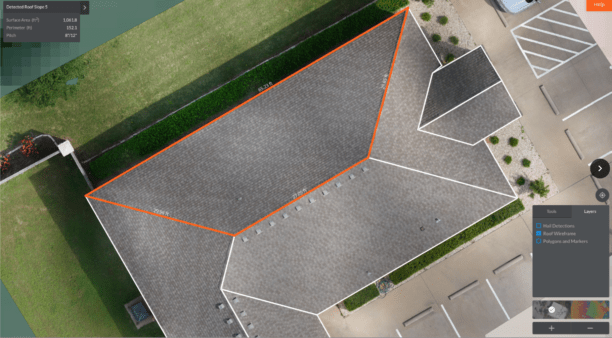
Sponsored post by Rosalie Bartlett, Marketing Manager, Kespry —
Drone technology is being adopted by large enterprise at an ever-increasing rate, as a wide variety of industries see the major returns that drone programs offer. But estimating the full ROI of a drone program can be tricky – not because the initial calculations aren’t clear, but because the real benefits of drone data keep accumulating over time.
The Initial ROI: Replacement Costs
Even at its simplest, the ROI for drone data is strong. Gathering data by drone replaces a time consuming and often dangerous process. Gathering industrial data from ground level – for mining, aggregates, insurance, or other purposes – is costly, time-consuming, and sometimes dangerous. Gathering industrial data from a manned aircraft requires specialized services and is so expensive that it cannot be performed often.
Using a drone to gather industrial data dramatically changes the process. The aggregates industry typically measured stockpile volumes on foot which was a difficult and time consuming job. Aggregates customers using a Kespry drone solution estimate that the same work is performed in such a dramatically shortened time that their labor costs for the task are reduced by 84%.
“Over three days, I drove 850 miles. I flew 23 missions over 718 acres. I captured data for 212 stockpiles. With my previous method, I could measure an average stockpile in about 45 minutes. With Kespry, I averaged 7.9 minutes per stockpile. That’s including the time it took me to drive 850 miles. We completed 173 hours of work in 28 hours. That’s an 84 percent reduction in labor costs for this single inventory measurement cycle. That’s over a month’s worth of work [completed] in three days.” – Kyle Huffman, Source Manager, Atlas Sand and Rock.
In the insurance industry, a recent white paper revealed that by using drone technology, property inspections are performed 5x faster – a significant boost for customer satisfaction – at 25% of the cost. And for mining companies, replacing the costs of a manned flight to survey assets with a few hours of drone operation by one of their own staff members reduces cost as well as the time it takes to receive usable data – from a week or more to a few hours.
As with any new technology, realizing maximum benefits means choosing the right system. A good drone solution must be fully autonomous: the Kespry system can be flown with a few taps on an iPad, no flight skills required. That means that your existing staff can easily be trained, keeping staffing costs steady, and the company can realize the benefits of the program quickly. Every customer has access to a dedicated customer success team.
The Next Step: New Data, New Value
Customers evaluating drone technology shouldn’t limit their calculations to strictly data capture replacement costs. Organizations find that drone data doesn’t just provide the same information more easily and cost-effectively, it provides a new and deeper level of insight.
For example, in the mining and aggregates industry gathering data on foot is not only time-consuming and difficult: it can also be inaccurate. Repeatability is a significant issue. In stockpile measurement, for example, inaccurate data can result in write-downs. An enterprise drone solution like Kespry delivers data with incredible accuracy and repeatability.
The raw data isn’t the final deliverable with a drone program – actionable insights are what provide real value. Kespry offers a full end-to-end solution for the enterprise – integrated vertically to make the process fast and easy. Data analysis happens automatically in the online Kespry Cloud, where the data gathered from the drone is processed, and delivered to customers in ways that add significant value. It can be downloaded in more than 30 file formats and used in a number of other programs. Data gathered by drone is so much more accurate and reliable that it doesn’t just replace other data, but can be used in entirely different ways.

The Long Term: The Benefits of Big Data
New and innovative AI technologies are expanding the value of big data analysis, and these technologies are being incorporated into analysis platforms like Kespry’s. The insights generated from large volumes of highly accurate business data – data previously unavailable to the enterprise – allow for transformational change.
Kespry’s enterprise drone solution provides not only the tools for automated and accurate data capture, but the online platform for data storage and a sophisticated toolset for data management, analysis, and reporting. As drone programs expand throughout the enterprise, the platform allows organizations to access integrated information about all aspects of the business.
While the initial ROI calculation for a drone program is easy, over time the returns may far exceed expectations. As companies find that accumulated drone data offers insights and analysis previously unavailable to them, the value of that data could move beyond a simple cost benefit analysis to a true transformation of business practices within enterprises and entire industries. And with drone industry innovation moving at an incredible pace to keep up with enterprise adoption, the ROI of drone data may expand to levels not yet considered.
To discuss how your company can see a strong ROI using drone technology, contact us.
 Rosalie Bartlett manages Marketing at Kespry, the leading provider of a complete aerial intelligence platform and is the Editor of Drones at Work. Prior to joining Kespry, she was the Editor of Commercial Drone News and consulted with commercial drone companies.
Rosalie Bartlett manages Marketing at Kespry, the leading provider of a complete aerial intelligence platform and is the Editor of Drones at Work. Prior to joining Kespry, she was the Editor of Commercial Drone News and consulted with commercial drone companies.
Email Rosalie | Follow Rosalie | Connect with Rosalie
.
Alan is serial entrepreneur, active angel investor, and a drone enthusiast. He co-founded DRONELIFE.com to address the emerging commercial market for drones and drone technology. Prior to DRONELIFE.com, Alan co-founded Where.com, ThinkingScreen Media, and Nurse.com. Recently, Alan has co-founded Crowditz.com, a leader in Equity Crowdfunding Data, Analytics, and Insights. Alan can be reached at alan(at)dronelife.com







[…] post The ROI of Drone Data for the Enterprise appeared first on DRONELIFE […]